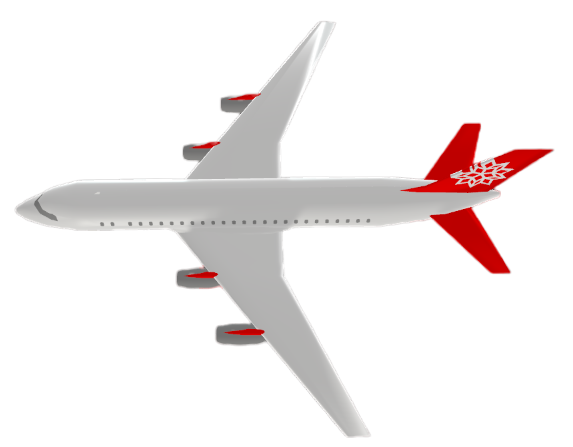WOLFRAM SYSTEM MODELER
IntroductionIntroduction to the theory for modeling the flight of an aircraft and to the contents of the Aircraft library |
|
Wolfram Language
SystemModel["Aircraft.Introduction"]

Information
Introduction
With the Wolfram System Modeler Aircraft library, you can model and simulate the flight of fixed-wing and rotary-wing aircraft. In this introduction, a short description of the aircraft library and common features of the fixed-wing and rotary-wing aircraft will be given. The Aircraft library provides a versatile tool for studying the flight mechanics, controllability and performance of an aircraft. The parametric nature of the aircraft models serves well for a quick testing of how the changes in some aircraft parameters affect their performance and characteristics. By having this rather quick and easy method for creating a model for aircraft dynamics, studying and designing control systems for different aircraft designs is also possible with the library. The drag-and-drop modeling environment also enables setting up multiple different flight scenarios, ranging from modeling an engine failure to a winch launch of a glider aircraft up in the air. This guide contains a brief introduction to the structure of the Aircraft library and a very short introduction to the theory behind the aircraft dynamics modeled in the library, which is common between the fixed-wing and rotary-wing. The documentation of each component in the library gives a more detailed explanation of its features and relevant theory.
The Aircraft library includes the following packages:
- Examples: Includes the fixed-wing and rotary-wing examples of different missions and scenarios.
- Physical: This package is divided into the fixed-wing and rotary-wing subpackges and provides the tools to model the physical body of the specific aircraft. RotaryWing Introduction and FixedWing Introduction give a more detailed insight into the modeling and the logic behind the physcial model.
- ControlSystems: This packge contains the controllers of MultiRotorControllers for rotary-wing and Autopilots for fixed-wing aircraft.
- StateSpace: Contains the Statespace model of the fixed-wing aircraft.
- Atmosphere: Contains the atmospheric model for fixed-wing aircraft.
- Utilities: Contains additional utilities used in the library.
Theory
This section includes a short description of the basic flight dynamics behind the models. To be able to use the Aircraft library and create your own aircraft design and simulate their flights does not require extensive knowledge about flight dynamics and aerodynamics. However, the standard terminology used in these fields is indeed very helpful to understand the language used in the library.
Aircraft Flight Dynamics
The motion of the aircraft is modeled for a rigid body with six degrees of freedom. It includes the flight mechanics phenomena coupling the different linear and angular motions along and around different axes to each other, as well as the dynamics between control actuators and the motion of the aircraft. The basis of the aircraft dynamics calculations is Newton's second law for linear and angular motion. For linear motion, it states that the aerodynamic forces gravity and thrust acting on the aircraft equal the time rate of change of the aircraft's momentum, whereas for angular motion the moments created by aerodynamic forces and thrust acting on the aircraft need to be equal to the time rate of change in angular momentum. These equations for each linear and angular motion are resolved in the body frame. The stability and control derivatives are used to couple the effects between different motions and control actions as well as to describe the damping effects.
Coordinate Systems
There are two coordinate systems of interest when modeling and simulating a flight: world frame and body frame. The world frame is the inertial coordinate fixed to the Earth and is mostly used to describe the aircraft's position and velocity for navigation. The local body frame, which is fixed to the center of mass of the aircraft, is used in the equations of motion, as it is more convenient for resolving the forces and moments in the body frame. The translation between these axis systems is defined by the position vector r0 from world frame origin to body frame origin resolved in the world frame. Figure 1 shows the orientation of the coordinate systems that are followed throughout the library.
Figure 1: The position vector r0 from world frame origin to body frame origin.
The Euler angles for roll (φ), pitch (θ) and yaw (ψ) define the rotations between the coordinate systems. The sequence of Euler angle rotations from world frame to body frame is first ψ around the world frame z axis, then θ around the rotated y axis, and last φ around the rotated x axis, as shown in Figure 2.
Figure 2: Sequences of Euler angle rotations from world frame to body frame and the directions of positive Euler angles.
These rotations result in a transformation matrix between the Euler rates (φ dot, θ dot and ψ dot) and the angular velocities of the aircraft resolved in the body frame, namely the roll rate (ṗ), pitch rate (q̇) and yaw rate (ṙ). There is also a transformation matrix between the velocity components in the world frame (vx, vy and vz) and in the body frame (u, v, w). These transformation matrices and their derivations are described further in Reference [1] on pp. 101–103.
References
[1] Nelson, R. C. (1998). Flight Stability and Automatic Control. 2nd ed. McGraw-Hill. Available at: http://home.eng.iastate.edu/~shermanp/AERE355/lectures/Flight_Stability_and_Automatic_Control_N.pdf.

